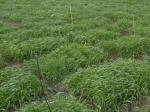Organization - JHI |
|
|
|
|
|
James Hutton Institute (JHI, previously Scottish Crop Research Institute) is situated in Invergowrie, a small village on the north shore of the Tay estuary in Eastern Scotland. Invergowrie lies to the west of Dundee. JHI is the lead centre in the UK for research on potatoes, barley and soft fruit crops and, in addition, carries out research on a wide range of temperate, sub-tropical and tropical crops, e.g. cassava, groundnut, mahogany and coffee. A broad, yet fully integrated programme of fundamental and strategic research of the highest quality is a special strength of the Institute. The range of skills available, from fundamental studies on genetics and physiology, through agronomy and pathology, to glasshouse and field trials is unique within the UK research service. In particular, SCRIJHI seeks to create and protect wealth in relevant industries, to improve the quality of life, and to protect the environment. Breeding programmes at JHI are responsible for new crop varieties that are widely released throughout the World. The 'Glen' series of raspberries account for over 96% of the Scottish and 70% of the UK certified stocks, whilst a fifth of the UK maincrop potato area is planted to JHI varieties including the 'Pentland' series, and more recent releases which are named after Scottish castles and other features. In the last five years, collaborative research links have been maintained with over 300 institutions in 54 countries. The Scottish Horticultural Research Institute (SHRI) was established in Invergowrie in the spring of 1951 with the object of undertaking organised research into the problems of horticultural production in Scotland. It became legally established as a self-governing, grant-aided research organisation in 1953. In February 1981, the long- established Scottish Plant Breeding Station (SPBS) based in Pentlandfield, Edinburgh, was amalgamated with SHRI at Invergowrie and was renamed the Scottish Crop Research Institute. More than 400 people work at JHI, from graduate scientists and visiting workers to support staff and students. Training is provided for PhD students and visitors from overseas by senior research scientists at JHI who supervise postgraduate students from universities throughout Scotland, the rest of the UK and across the world. JHI scientists have access to almost 5,000 m2 of fully-equipped, high-quality laboratory facilities. The Institute has 172 hectares of land, mostly free draining, rising from 15 to 140m above sea level, adjacent to the laboratory complex and which is available for field experiments. There is a total of over 11,000m2 glasshouse accommodation on site, most of it with heating and supplementary lighting to provide year-round growing conditions. For more closely controlled conditions, there are over 90 growth cabinets and walk-in rooms of varying capacity totalling c. 700m2 floor area. The John Home Robertson Research Glasshouse, opened in June 2000, is Scotland's most sophisticated complex, with the most up-to-date facilities available for controlled, contained studies. Research relevant for BarleyGenomeNet (selection)Virus-derived expression vectors and virus induced gene silencing: mechanisms and application for gene function studies in barley (Christophe Lacomme, JHI)The development and optimisation of virus-derived expression vectors for gain-of-function (overexpression) or loss-of-function (virus induced gene silencing, VIGS) screens benefit from the study of plant virus functions (cell-to-cell and long distance movement, in planta distribution) and the nature of RNA structure in eliciting a silencing response and RNA-mediated defense. Plant virus-derived vectors with increased root tropism, developing an enhanced silencing response and triggering VIGS in crop species have been developed. Plant viruses can be used for the functional characterization of plant genes in order to identify their role during pathogen resistance. This was exemplified with the use of Barley stripe mosaic virus VIGS vector for barley (Hordeum vulgare) to characterize the function of genes required for resistance (Mla-mediated) towards the biotrophic barley pathogen Blumeria graminis f. sp. hordei (collaboration with Ken Shirasu, Sainsbury laboratory Norwich, UK). BSMV-VIGS-based approach confirmed the requirement of Rar1, Sgt1 in Mla-resistance and demonstrates that Hsp90 was as well required for Mla-resistance in barley. BSMV-induced VIGS is a powerful tool for the rapid characterization of genes involved in pathogen resistance in barley. Pathology of fungal diseases of cereals at JHI focuses on leaf blights, particularly Rhynchosporium secalis on barley (Adrian C. Newton, SCRIJHI). Disease control measures include understanding specific and polygenic resistance mechanisms at a molecular level through to field deployment in spatial and temporal dimensions including crop canopy structure interactions and heterogeneity traits. Resistance is also being studied at the phenotypic and genotypic level through mapping, Tilling (collaboration Robbie Waugh's team, SCRIJHI) and association genetics. Pathogen population shifts in response to control measures and deployment strategies are studied using molecular as well as pathogenic traits. Association Genetics of UK elite barley (R. Waugh, JHI)A large project (approx. ?3 million) is dedicated to explore underlying genetic mechanisms that control yield, quailty and environmental sustainability of barley. Improving economically important characteristics of barley such as yield, resistance to pests and diseases (which dictates how much the crop will need to be sprayed to protect it) and the amount of alcohol that can be extracted from it during the process of making 'malt' whisky are key targets of commercial barley breeders. The breeders challenge is always to identify a daughter line that is better than the parents for one or more of the selected characters. The research funding will allow the SCRIJHI Barley Research Group to look for the genes that control the characters that are important for improving barley production and use. While this will be a stiff challenge, this project brings experimental and analytical tools used in human and plant genetic studies to identify and understand how natural gene variants influence desireable plant characters. It will take advantage of local expertise in statistics, and extensive plant materials and datasets available through UK national plant evaluation trials. |
|
Barley Genome Net - Organisation - JHI |
|
|
|
|
|
|


